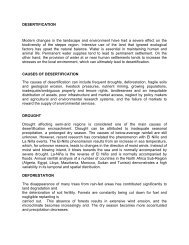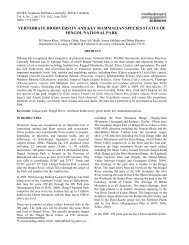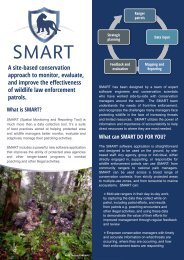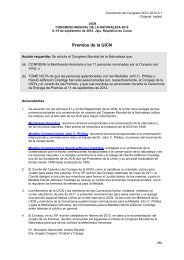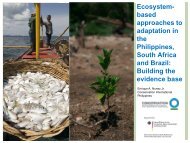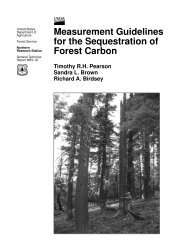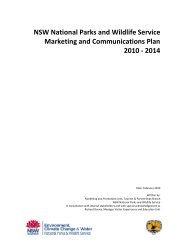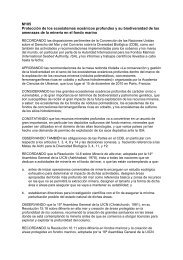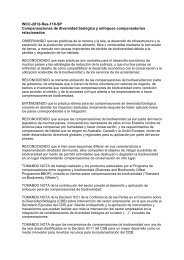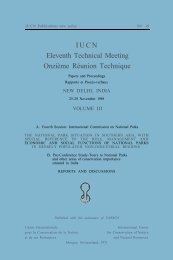Sakhalin-2 Project and Western Gray Whales: lessons learnt - IUCN ...
Sakhalin-2 Project and Western Gray Whales: lessons learnt - IUCN ...
Sakhalin-2 Project and Western Gray Whales: lessons learnt - IUCN ...
Create successful ePaper yourself
Turn your PDF publications into a flip-book with our unique Google optimized e-Paper software.
<strong>Sakhalin</strong>-2 <strong>Project</strong> <strong>and</strong> <strong>Western</strong><br />
<strong>Gray</strong> <strong>Whales</strong>: <strong>lessons</strong> <strong>learnt</strong><br />
Author: Alexey Vladimirov, PhD<br />
Date: 09.09.2012<br />
Security Classification: Non-restricted
<strong>Sakhalin</strong>-2 <strong>Project</strong><br />
<strong>and</strong> <strong>Sakhalin</strong> Energy
<strong>Sakhalin</strong> Energy<br />
<strong>Sakhalin</strong> Energy Headquarter<br />
• Established in 1994<br />
• Operates under Production Sharing<br />
Agreement with Russian Federation <strong>and</strong><br />
<strong>Sakhalin</strong> Oblast Administration<br />
• Investor <strong>and</strong> operator of the <strong>Sakhalin</strong>-2<br />
project.<br />
• Owns licenses for the development of<br />
offshore Lunskoye <strong>and</strong> Piltun-<br />
Astokhskoye oil <strong>and</strong> gas fields on<br />
<strong>Sakhalin</strong> Isl<strong>and</strong> shelf, Russia.<br />
• Company’s shareholders are:<br />
‒ Gazprom - 50% plus one share;<br />
‒ Shell – 27,5%;<br />
‒ Mitsui – 12,5%;<br />
‒ Mitsubishi – 10%.<br />
• Two offices:<br />
‒ head office in Yuzhno-<strong>Sakhalin</strong>sk;<br />
‒ representative office in Moscow.<br />
3
Corporate Management<br />
4
Climate <strong>and</strong> Geography in the Area of Operations<br />
Piltun-Astokhskoye<br />
field<br />
<strong>Sakhalin</strong><br />
Lunskoye field<br />
Yuzhno-<strong>Sakhalin</strong>sk<br />
Winter season:<br />
220-240 days;<br />
Average Temperatures:<br />
winter, in the north: –24°С;<br />
in the south: –6°С<br />
summer, in the north: +10°С;<br />
in the south: +19°С<br />
the lowest: –35 - –42 о С<br />
the highest: +27 - +35 о С<br />
Ice season:<br />
6-6.5 months<br />
Storm wave height:<br />
13-16 m<br />
Seismic activity:<br />
(up to 7-8 points)<br />
5
<strong>Project</strong> Infrastructure<br />
Launched in 1996 with Molikpaq (PA-A) platform -<br />
first fixed ice-class production platform in Russia.<br />
The first system for minimal flaring of associated<br />
gas ever used in Russia.<br />
First oil achieved in July 1999.<br />
Piltun-Astokhskoye-B <strong>and</strong> Lunskoye-A CGBS are<br />
the first structures built in Russia.<br />
Installed on the <strong>Sakhalin</strong> sea shelf in 2005.<br />
Lun-A topsides installed on <strong>Sakhalin</strong> in June 2006 -<br />
First gas offshore platform in Russia.<br />
PA-B topsides installed in July 2007, a world record<br />
for marine works.<br />
Finalization of the pipeline system <strong>and</strong> year-round<br />
oil production since October 2008.<br />
Start-up of the first LNG plant <strong>and</strong> the first offshore<br />
gas production in Russia in 2009<br />
6
Geography of LNG <strong>and</strong> Oil Trade<br />
10,6 mln t/y of<br />
LNG is an equivalent<br />
9% of of all<br />
Russian gas<br />
exported to Europe.<br />
4% of global<br />
LNG market<br />
43 mln bbl/y of oil<br />
7
Supplies of <strong>Sakhalin</strong> Oil <strong>and</strong> LNG<br />
(2011)<br />
Oil supplies<br />
LNG supplies
<strong>Sakhalin</strong>-2 <strong>Project</strong><br />
• It is one of the world’s largest integrated oil <strong>and</strong> gas production projects.<br />
• It is the first project in Russia to develop offshore oil <strong>and</strong> gas fields.<br />
• The <strong>Sakhalin</strong>-2 is the first project in Russia developed under Production<br />
Sharing Agreement (PSA).<br />
• It is the first project in Russia to be “<strong>Project</strong> Financed”.<br />
• The project was conducted in two phases:<br />
‒ Phase 1 – development of Astokh area of Pultun-Astokhskoe field;<br />
‒ Phase 2 – full development of Piltun-Astokhskoe <strong>and</strong> Lunskoye fields.<br />
• It includes three offshore platforms (PA-A, PA-B, Lun-A), an onshore<br />
processing facility (OPF), Trans<strong>Sakhalin</strong> pipeline system, liquefied natural gas<br />
(LNG) plant <strong>and</strong> oil export terminal (OET).<br />
• One of the most complex <strong>and</strong> innovative <strong>Project</strong> in the World.<br />
9
<strong>Sakhalin</strong>-2 <strong>Project</strong> <strong>and</strong><br />
Environment
Our Home<br />
<strong>Sakhalin</strong> Isl<strong>and</strong> is the biggest isl<strong>and</strong> in the<br />
Russia:<br />
• territory – 87,000 km 2 .;<br />
• length – 948 km;<br />
• rich onshore <strong>and</strong> offshore wildlife;<br />
• endangered endemic <strong>and</strong> relic species of<br />
plants, fish, birds <strong>and</strong> mammals<br />
• fragile ecosystems;<br />
• population – appr. 500,000 people;<br />
• indigenous communities<br />
• lack of infrastructure;<br />
• economics is highly depended on fishery<br />
11
Environmental Programmes<br />
• Steller’s Sea Eagle Monitoring<br />
• <strong>Western</strong> <strong>Gray</strong> Whale Monitoring<br />
• Marine Mammals Observation<br />
• Offshore Local Environmental Monitoring<br />
• Ballast Water Monitoring<br />
• Monitoring of Invasive Species in Aniva Bay<br />
• <strong>Sakhalin</strong> Taimen Monitoring<br />
• Monitoring of Rare <strong>and</strong> Threatened Birds<br />
• Monitoring of Wetl<strong>and</strong>s<br />
• Monitoring of Rivers Ecology<br />
• Monitoring of L<strong>and</strong>scape Processes<br />
• Monitoring of Flora <strong>and</strong> Wegetation<br />
• Monitoring of Terrestrial Mammals<br />
• Remote Sensing Programme<br />
• Monitoring of Soils<br />
• Archeology <strong>and</strong> Monitoring of Cultural Heritage<br />
12
<strong>Western</strong> <strong>Gray</strong> <strong>Whales</strong> - baseline<br />
• Considered to be extinct by the middle<br />
of XX century<br />
• Discovered near <strong>Sakhalin</strong> Isl<strong>and</strong> in 1983<br />
• A lot of uncertainties <strong>and</strong> luck of data<br />
• Consists of 80-100 individuals<br />
• Thought to be slightly decreasing<br />
• The only feeding area located near<br />
Piltun Bay offshore north-east coast of<br />
<strong>Sakhalin</strong> Isl<strong>and</strong><br />
• Extremely important for calf survival<br />
• Unique fragile habitats<br />
• Threatened to extinction by oil <strong>and</strong> gas<br />
exploration<br />
Photo by Yu.Yakovlev<br />
13
Joint <strong>Western</strong> <strong>Gray</strong> Whale Monitoring<br />
<strong>Sakhalin</strong> Energy started to research <strong>Western</strong> <strong>Gray</strong> <strong>Whales</strong> in 1997. Since 2002<br />
has cooperated with Exxon Neftegaz Limited, operator of <strong>Sakhalin</strong>-1 <strong>Project</strong>, to<br />
conduct these studies under the joint Programme. The key objectives are:<br />
•to monitor the spatial <strong>and</strong> the temporal distribution <strong>and</strong> abundance in both nearshore<br />
<strong>and</strong> offshore feeding areas<br />
•to acquire information about the composition of benthos, food availability <strong>and</strong><br />
sustainability of the feeding habitats<br />
•to gather the information about the demographic structure <strong>and</strong> ecology of the<br />
<strong>Western</strong> <strong>Gray</strong> Whale population <strong>and</strong> to assess the population size <strong>and</strong> dynamic<br />
•to measure the ambient noise <strong>and</strong> the different variations in the sound levels in<br />
the feeding areas resulting from the anthropogenic activities<br />
•to monitor the inter-seasonal <strong>and</strong> the inter-annual variability in the hydrological<br />
parameters that may have the effects on the productivity <strong>and</strong> the biomass of the<br />
benthos<br />
•to develop scientific-based protective measures based on the most recent data<br />
14
Photo by Yu.Yakovlev<br />
Programme Components<br />
The studies under the Programme (2002-2012):<br />
1.Aerial-based Distribution surveys (dropped in 2006)<br />
2.Vessel-based Distribution surveys (started in 2002; in the current scope for 2012)<br />
3.Shore-based Distribution surveys (started in 2003; in the current scope for 2012)<br />
4.Shore-based Behaviour studies (moved to activity-based in 2011)<br />
5.Shore-based Acoustic studies (moved to activity-based in 2007)<br />
6.Vessel-based Acoustic studies (started in 2003; in the current scope for 2012)<br />
7.Vessel-based Hydrological studies (started in 2006; in the current scope for 2012)<br />
8.Vessel-based Photo-ID studies (started in 2002; in the current scope for 2012)<br />
9.Vessel-based Benthic studies (started in 2002; in the current scope for 2012)<br />
10.Vessel-based Biopsy sampling (started in 2010; in the current scope for 2012)<br />
The joint studies outside the Programme:<br />
1.Kamchatka Distribution <strong>and</strong> Photo-ID studies (started in 2008; dropped in 2012)<br />
2.Vessel-based Satellite tagging (started in 2010; postponed till 2013)<br />
15
Key Findings<br />
• The second feeding area was found in the eastern <strong>Sakhalin</strong> offshore waters <strong>and</strong><br />
boundaries of the both Piltun <strong>and</strong> Offshore feeding areas were determined<br />
• The number of <strong>Gray</strong> <strong>Whales</strong> feeding near north-east <strong>Sakhalin</strong> is assessed of over<br />
131 living animals <strong>and</strong> slightly increases (about 3% a year)<br />
• The duration, start <strong>and</strong> end dates of main feeding period near <strong>Sakhalin</strong> were<br />
determined<br />
• <strong>Gray</strong> whales feeding near <strong>Sakhalin</strong> are back to healthy physical conditions to the<br />
autumn<br />
• New <strong>Gray</strong> Whale feeding areas within the Russian Far East waters were discovered<br />
• Mother with calves can be met not in Piltun feeding area only <strong>and</strong> the same pairs <strong>and</strong><br />
yearlings were sighted feeding near <strong>Sakhalin</strong> <strong>and</strong> Kamchatka within one season<br />
• There was no evidence or statistically significant record of the negative impacts of<br />
industrial activities on the pods or individual <strong>Gray</strong> <strong>Whales</strong> or other cetaceans near<br />
<strong>Sakhalin</strong><br />
• The recent Photo-ID <strong>and</strong> Satellite tagging data shows that at least the part of <strong>Gray</strong><br />
<strong>Whales</strong> feeding near <strong>Sakhalin</strong> belongs to Eastern <strong>Gray</strong> Whale population<br />
16
"This research was conducted by A.N.<br />
Severtsov Institute of Ecology <strong>and</strong><br />
Evolution of the Russian Academy of<br />
Sciences (IEE RAS) <strong>and</strong> Oregon State<br />
University Marine Mammal Institute in<br />
collaboration with the U.S. National<br />
Marine Fisheries Service, Kronotsky<br />
State Nature Biosphere Reserve <strong>and</strong><br />
the Kamchatka Branch of the Pacific<br />
Institute of Geography. The research<br />
was contracted through the<br />
International Whaling Commission<br />
(IWC) <strong>and</strong> International Union for<br />
Conservation of Nature (<strong>IUCN</strong>) with<br />
funding from Exxon Neftegas Ltd. <strong>and</strong><br />
<strong>Sakhalin</strong> Energy Investment Company<br />
Ltd."<br />
Satellite Tagging<br />
17
Risk Mitigation <strong>and</strong> Protective<br />
Measures
<strong>Western</strong> <strong>Gray</strong> Whale Advisory Panel<br />
In 2003 <strong>Sakhalin</strong> Energy approached <strong>IUCN</strong> to create <strong>and</strong> convene<br />
independent international Panel of the best marine mammal experts to<br />
strengthen <strong>Gray</strong> whale conservation:<br />
• ISRP established in 2004<br />
• WGWAP established in 2006<br />
• In 2011 WGWAP m<strong>and</strong>ate was renewed for another 5 years<br />
Goals <strong>and</strong> objectives:<br />
• Increase the output from <strong>Gray</strong> whale research <strong>and</strong> monitoring<br />
• Provide advice on how industry can minimize the impacts<br />
• Provide advice on protective measures required<br />
Specific tasks:<br />
• Review Joint Programme Results<br />
• Review Marine Mammal Protection Plan<br />
• Review Oil Spill Response Plans<br />
• Develop Monitoring <strong>and</strong> Mitigation Measures<br />
19
Marine Mammal Protection Plan<br />
First version of MMPP was developed in 2001<br />
<strong>and</strong> was based on the world’s best available<br />
practice (Vers.08 is currently in force):<br />
• Establishment of navigation corridors for<br />
vessels<br />
• Prohibition to enter <strong>Gray</strong> whale feeding<br />
grounds<br />
• MMOs onboard every vessel<br />
• Vessel speed limitations<br />
• Minimum flight heights limitations<br />
• Special measures to avoid collisions<br />
• Regular revision of MMPP according to the<br />
most recent scientific information<br />
• Reviewing by WGWAP before adoption<br />
20
2006 Pipeline Re-routing<br />
• In 2003 the base case for pipeline route<br />
was directly from PA-A to shore<br />
• Noise Modeling for different options<br />
• In 2005 based on ISRP report the<br />
Alternative route 3 was chosen to<br />
prevent crossing Piltun Feeding Area<br />
• Pipeline construction was held in 2006<br />
• Acoustic Monitoring during the<br />
construction<br />
• Behavior Monitoring during the<br />
construction<br />
• MMOs onboard every vessel<br />
• Mitigation Measures to Physical <strong>and</strong><br />
Chemical Impacts<br />
21
2010 4-D Seismic Survey<br />
•Archival acoustic recording of natural <strong>and</strong> humangenerated<br />
sounds before, during, <strong>and</strong> after the<br />
survey;<br />
•Sound propagation modelling <strong>and</strong> in situ verification<br />
of acoustic footprints around operations in relation to<br />
important whale habitat areas;<br />
•Real-time measurements of sounds produced<br />
during the survey <strong>and</strong> strict adherence to specific<br />
operational protocols based on received sound<br />
levels;<br />
•Shore-based visual detection of whales using scan<br />
sampling techniques;<br />
•Shore-based monitoring of movements <strong>and</strong><br />
behaviour of individual whales using theodolite<br />
tracking; <strong>and</strong><br />
•Vessel-based visual detection of whales by onboard<br />
observers with direct authority to call for specific<br />
changes in operations (including shut-down) based<br />
on whale proximity <strong>and</strong> behaviour.<br />
Prepared by R.Racca<br />
22
2012 2-D Seismic Survey<br />
The main mitigation measure is to start <strong>and</strong> complete survey as early in the season<br />
as ice conditions allow to prevent noisy activities during the main feeding period.<br />
•Archival acoustic recording of natural <strong>and</strong><br />
human-generated sounds before, during,<br />
<strong>and</strong> after the survey;<br />
•Sound propagation modelling <strong>and</strong> in situ<br />
verification of acoustic footprints around<br />
operations in relation to important whale<br />
habitat areas;<br />
•Shore-based monitoring of movements <strong>and</strong><br />
behaviour of individual whales using<br />
theodolite tracking; <strong>and</strong><br />
•Vessel-based visual detection of whales by<br />
onboard observers with direct authority to<br />
call for specific changes in operations<br />
(including shut-down) based on whale<br />
proximity <strong>and</strong> behaviour.<br />
Modeled by JASCO Research Ltd.<br />
23
South Piltun <strong>Project</strong><br />
• Production Sharing Agreement<br />
prescribes to ensure full exploration of<br />
the license area<br />
• Hydrocarbon deposits cannot be<br />
developed from PA-A or PA-B platforms<br />
• There are several options which are<br />
highly depend on many factors including<br />
the commerciality of the <strong>Project</strong><br />
• One of the options is a construction of a<br />
3 rd platform between the existing <strong>and</strong><br />
further offshore but the decision hasn’t<br />
been taken yet<br />
• Basic environmental risks are not<br />
different from the other platforms but the<br />
assessment of cumulative impact is the<br />
issue to be addressed<br />
PA-A<br />
PA-B<br />
South Piltun<br />
24
The Challenge
Steps Forward<br />
• The joint work <strong>IUCN</strong>, <strong>Sakhalin</strong> Energy <strong>and</strong> WGWAP is very efficient<br />
<strong>and</strong> positive <strong>and</strong> should serve as an example of the bridge between<br />
conservation <strong>and</strong> development needs<br />
• The experienced gained should be considered as a BAP <strong>and</strong> used in<br />
other projects worldwide<br />
• Conservation requires an open dialog with various stakeholders<br />
• Need of information about the activities of other operators<br />
• Lack of information about other offshore activities (non-related to<br />
oil&gas exploration)<br />
• Lack of information about potential impacts along the migration routes<br />
<strong>and</strong> at the breading grounds<br />
• A lot of gaps in our knowledge about <strong>Gray</strong> whales<br />
• A broad cooperation is essential within the <strong>Gray</strong> whale range<br />
• International-based mechanism of management is required<br />
26
Thank you for your attention!<br />
Contact us<br />
Tel.: +7 (4242) 66 2000<br />
Fax: +7 (4242) 66 2012<br />
E-mail: Ask-<strong>Sakhalin</strong>energy@sakhalinenergy.ru<br />
Web site: www.sakhalinenergy.com



